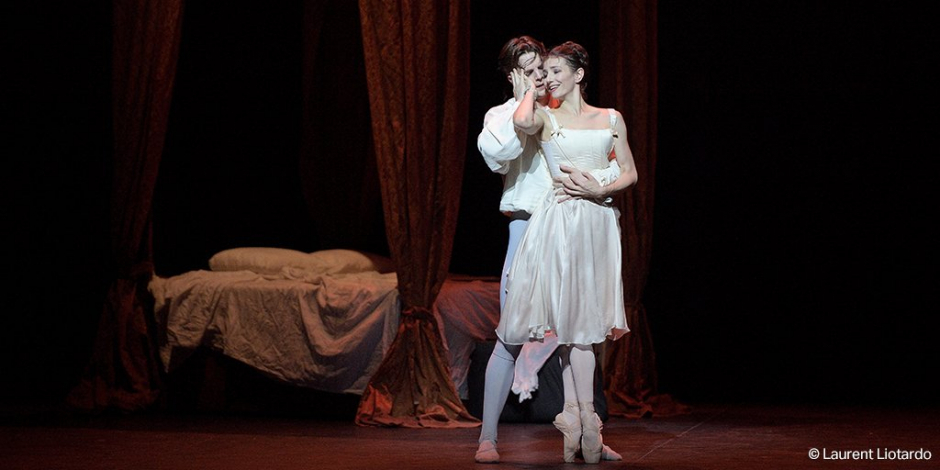Manon | Manchester Opera House
The Parisian tale of desire, decadence, and doom was produced by the late Kenneth MacMillan in 1974 and was his third full-length production as resident choreographer for the Royal Ballet. Manon followed his widely successful Romeo and Juliet (1965) and his second masterpiece, Anastasia (1971), which was met with a mixed reception at the time of its release. After Anastasia, and in an attempt to be more ‘political’, MacMillan leant towards Abbé Prévost’s 18th century novel L’Histoire du Chevalier des Grieux et de Manon Lescaut, which featured a more natural operatic tale and form but opted for the stunning musical arrangement of Massenet over Puccini. Critics were surprisingly late to get on board with the atypical ballet heroine – dubbing Manon a ‘slut’ – but the public showed instant affection. Now, the 40 year-old chef-d’œuvre continues to seduce spectators in its revival, as the English National Ballet once again takes Manon out of the capital on tour around the UK.
It was perhaps the rarity of seeing Manon performed by the English National Ballet in Manchester that filed the Opera House on opening night. The audience showcased the production’s ability to reach across generations: students, young couples and elderly groups of friends gathered to watch Manon performed by a team of talented dancers to a full orchestra lead by acclaimed conductor Martin Yates.
The opening scene was a whirlwind of movement and set the bar for what was to follow. Nearly 30 dancers dressed head to toe in elaborate French post-Renaissance costumes were grouped on the stage. The divide between opulence and depravity was highlighted by the lavish and colourful costumes of the wealthy and torn rags of the poor. Their respective activities interacted well, with poor men stealing watches and prostitutes endeavouring to seduce the rich men, artistically setting the scene for a plot that focuses on class stratification. The dancing was playful and the music cheerful; together they made a grand gesture to introduce MacMillan’s masterpiece and prepared for the arrival of the protagonist, Manon.
The lead character stepped on stage as an innocent. Exquisitely performed by Romanian ballerina, Alina Cojocarut, Manon was graceful, weightless and nymph-like. She embodied an ethereal purity with her movements, directed by the other male dancers as she stepped daintily around the stage. MacMillan’s choreography subtly transformed her character throughout the ballet as bolder, solo moves slowly eroded the portrayal of innocence and the seemingly sweet became the sinful.
Prévost’s story situates the protagonist as torn between her love for the penniless Des Greiux and the privileged life offered by Monsieur GM, whom her brother, Lescaut, has essentially sold her to. Manon’s initial struggle to refute the allure of affluence is what thwarts her from being the conventional heroine usually depicted in classic ballets. MacMillan reflected on her character as somewhat more realistic; ‘Manon is not so much afraid of being poor as ashamed of being poor. Poverty in that period was the equivalent of long, slow death’.
Through MacMillan’s statement pas de deux, we saw the heartrending transformation of Manon occur. The first materialised when Des Grieux first falls in love with her, observed with soft and romantic gestures and dreamy musical accompaniment. In perhaps the most iconic scene of Act I, the second key pas de deux took place in the ‘bedroom’ scene. Manon, notably in a new silkier, nude attire, and Des Grieux had us enraptured with their passion as they threw their bodies at each other with energy and fervour. At this point, Manon had left her chaste virtue behind but remained a hopeless romantic.
After the flamboyant opening scene of Act II, which outfitted colourful tutus and saw Jeffrey Circiot humorously and vivaciously portray a drunk Lescaut, the third major pas de deux occurred. Manon had forsaken the rich Monsieur GM and returned to her former lover, but still wore the diamond gifts that served as a painful reminder of her betrayal. This pas de deux was played out through harmonic and mirrored dancing as the lovers stepped in time to one another before dramatically shifting into harsher motions as De Grieux became jealous over the jewellery.
The final pas de deux wrapped up the emotional journey of MacMillan’s Manon. The concluding scene was set in Louisiana and witnessed the character’s ultimate fall from grace. Manon had been deported to New Orleans by Monsieur GM and the besotted Des Grieux had followed her there. Smoke filled the stage as a fragile Manon and Des Grieux gave the audience a sombre last dance. As the curtain fell the audience roared with applause; particularly for the two principal leads: the elegant and technically-masterful Cojocarut (Manon) and the charismatic Ciriot (Lescaut). They left Manchester Opera House with a sense of an emotional and tragic journey travelled. The groundbreaking rework of the vintage novel and traditional opera by MacMillan can arguably be considered his signature piece. MacMillan’s Manon is sure to be around for a long time.
by Aminah Barnes, a writer with TickX

